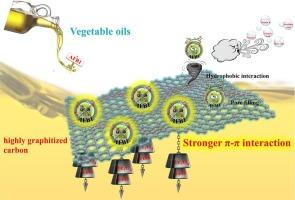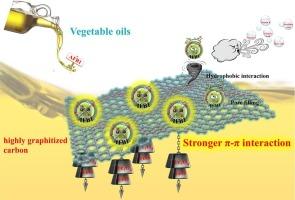具有增强π -π相互作用的高石墨化碳作为高效固相萃取吸附剂用于植物油中黄曲霉毒素B1的超灵敏分析
IF 9.8
1区 农林科学
Q1 CHEMISTRY, APPLIED
引用次数: 0
摘要
黄曲霉毒素B1 (AFB1)存在于油脂中,对食品安全构成威胁。碳基固相萃取(SPE)方法可以有效地检测含水食品基质中的AFB1,但由于非极性环境,将其应用于油类具有挑战性。我们通过过渡金属(Fe, Co, Ni)辅助碳化工艺,开发了具有增强π-π相互作用的高石墨化碳材料(HGC),用于石油中AFB1的提取。吸附实验表明,FeO/Fe3O4/HGC对AFB1的吸附量为1179.99 μg g−1,是Ni/Co-HGC和纯碳的4-6倍。密度泛函理论表明,磁性FeO/Fe3O4团簇支持的缺电子石墨化碳结构增强了与AFB1的π-π相互作用,孔隙填充和疏水性进一步帮助吸附。FeO/Fe3O4/ hplc - spe联合HPLC-FLD实现了植物油中AFB1的超灵敏检测(2.0 pg g−1限)。本研究为植物油中AFB1的检测提供了一种有效的方法,支持对污染进行监测和控制,提高食品安全。本文章由计算机程序翻译,如有差异,请以英文原文为准。


Highly graphitized carbon with enhanced π–π interactions as efficient solid phase extraction adsorbent for ultra-sensitive analysis of aflatoxin B1 in vegetable oils
Aflatoxin B1 (AFB1) threatens food safety due to its persistence in oils. Carbon-based solid-phase extraction (SPE) methods are effective for detecting AFB1 in aqueous food matrices, but employing it in oils is challenging due to non-polar environments. We developed highly graphitized carbon materials (HGC) with enhanced π-π interactions for AFB1 extraction in oil through a transition metal (Fe, Co, Ni)-assisted carbonization process. Adsorption experiments revealed that FeO/Fe3O4/HGC exhibited a superior AFB1 adsorption capacity of 1179.99 μg g−1, outperforming Ni/Co-HGC and pure carbon by 4–6 times. Density functional theory revealed the electron-deficient graphitized carbon structures supported by magnetic FeO/Fe3O4 clusters enhance π-π interactions with AFB1, with pore filling and hydrophobicity further aiding adsorption. Combining FeO/Fe3O4/HGC-SPE with HPLC-FLD achieved ultra-sensitive AFB1 detection in vegetable oils (2.0 pg g−1 limit). This study provides an effective method for AFB1 detection in vegetable oils, supporting the monitoring and control of contamination to enhance food safety.
求助全文
通过发布文献求助,成功后即可免费获取论文全文。
去求助
来源期刊

Food Chemistry
工程技术-食品科技
CiteScore
16.30
自引率
10.20%
发文量
3130
审稿时长
122 days
期刊介绍:
Food Chemistry publishes original research papers dealing with the advancement of the chemistry and biochemistry of foods or the analytical methods/ approach used. All papers should focus on the novelty of the research carried out.
 求助内容:
求助内容: 应助结果提醒方式:
应助结果提醒方式:


